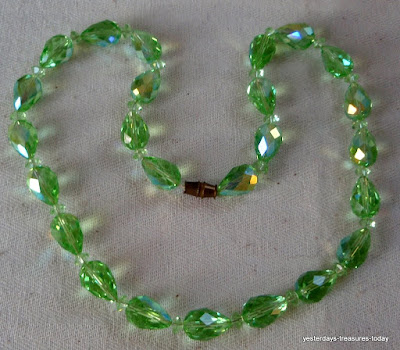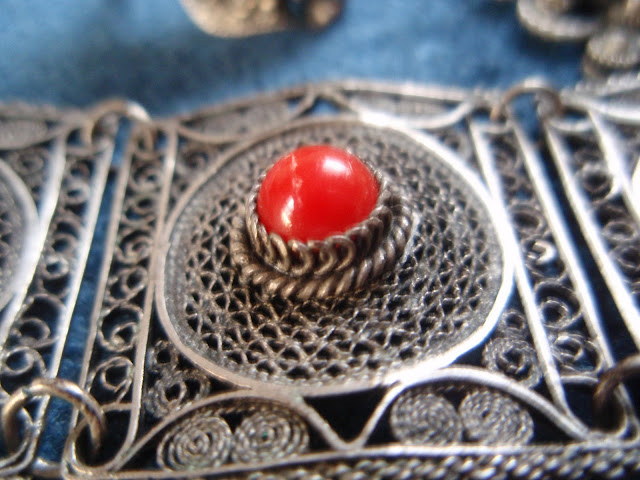In the 21st Century where the ‘big boogie man’ is some far off ancient granny-looking old man - the Far Eastern leader setting off World War III with the use of nuclear bombs it is hard to accept the facts.
It seems incredible to collectors of vintage costume jewellery that almost 100 years ago, glass artisans in Bohemia were adding uranium and other radioactive ingredients in limited quantities to their glass melt, to try to increase demand for their rare and unique items of (now vintage) costume jewellery.
But it is true – the addition of uranium (in particular) dates back decades. In the 1920’s what was thought to be a new and previously unknown range of sparkling glass was created for glass beads by those well known glass innovators: The Bohemians.
There are two colours of exceptional importance – the first a fluorescent green (achieved with the addition of low quantities of uranium) and yellow which created a glowing yellow which glows under dark conditions.
Another little known radioactive ingredient was selenium which produces the rare and incredibly beautiful pale peach orange rosalin another Bohemian crystal. Rosalin was produced in very limited quantities and of course, its demand would have been much higher, if only collectors of Bohemian glass were aware of the full story!
What with all the ‘Frankenstein Fakes’ coming out of what is now the Czech Republic, it is often difficult to tell what is genuine Bohemian or what is a genuine Bohemian craftsman’s worst nightmare (as seen regularly on eBay throughout the world).
Uranium enriched glass started to be used around 1840 by major manufacturers. Another resurgence of interest happened in around 1880 with the production of fancy Victorian ‘Vaseline Glass’ as it is now often called by collectors worldwide. As usual, the Brits were at the forefront of this trend. The products were highly sought after by the English and North American markets, who were, as usual, streets ahead of the continental markets.
These latest fashion was limited mostly to the English and American markets. The Continentals were slow to catch on to the beauty of these enriched glass products.
Selenium Glass, that beautiful peach rose crystal, was invented later, around 1891 by F. Welz of Klostergrab in Bohemia. If it was not for the enthusiasms of the educated American and English markets, this colour of enriched glass would not have become such a commercial success.
Uranium enriched glass started to be used around 1840 by major manufacturers. Another resurgence of interest happened in around 1880 with the production of fancy Victorian ‘Vaseline Glass’ as it is now often called by collectors worldwide. As usual, the Brits were at the forefront of this trend. The products were highly sought after by the English and North American markets, who were, as usual, streets ahead of the continental markets.
These latest fashion was limited mostly to the English and American markets. The Continentals were slow to catch on to the beauty of these enriched glass products.
Selenium Glass, that beautiful peach rose crystal, was invented later, around 1891 by F. Welz of Klostergrab in Bohemia. If it was not for the enthusiasms of the educated American and English markets, this colour of enriched glass would not have become such a commercial success.
The Continentals (including French and Germans) were never partial to this coloured glass, so production was limited to exports to America and England. Dressing table sets of this superb crystal were produced, but only in limited quantities. The most famous of producers of this now rare crystal were Siebert and Marquardt, Gorlitz, 1930. Crystal beads of this colour are exceptionally rare.
Joseph Riedel was one of the very earliest Bohemian dynasties to create the unusual radioactive crystals (1816-1894). His ancestors referred to him as the ‘Glass King of the Iser Mountains” (as quoted in 1726-1800).
The Riedels had owned and worked several glass producing furnaces and supplied quality and rare canes and tubes to their customers for many years, with which to make fancy beads. This dynasty are the first to be documented as makers of Alabaster glass and they probably were the first to introduce uranium enriched crystals to the market.
The Riedels had owned and worked several glass producing furnaces and supplied quality and rare canes and tubes to their customers for many years, with which to make fancy beads. This dynasty are the first to be documented as makers of Alabaster glass and they probably were the first to introduce uranium enriched crystals to the market.
It is said the naming of the yellow variety of uranium called ‘annagelb’ and the green version ‘annagreen’ were a tribute to Mrs. Riedel by Mr. Riedel.
Nerves jangle when one considers that these fabulous jewels contain a well known threat to health. Such microscopic amounts were used in the making that these items are most likely safe - but as we all know – nothing in life is absolutely safe. There is always an element of risk however small. If it were considered today in the 21st century, there is very little chance that ‘the nanny state’ would permit such experimentation with original ground-breaking products.
But back in the 1800’s the enrichment of the glass melt with uranium or selenium gave the glass makers a plethora of new possibilities. Until the relaxation of this overly careful supervision, it seems unlikely that any other new discoveries will survive the strict ‘nanny state’ designed to improve our health but which actually restricts our world in ways we cannot even imagine.
New glass products including ‘Annagelb and Annagreen’ from Bohemia, not to mention the ‘Topaz’ being produced in England, were the talk of the town, in most international non-provincial cities.
This successful experimental colours doubtless lead on to other possibilities including ivory, amber, turquoise and Burmese glass.#
The popularity of these glowing glasses is probably explained in as much during the time of their production, when mankind was entirely dependent upon the light from the sun and moon, supplemented by candle light for their activities.
To see Annagrun and Annayellow glowing in the moonlight in a dim candlelite room must have been an incredibly amazing sight. Hence its popularity.
Nerves jangle when one considers that these fabulous jewels contain a well known threat to health. Such microscopic amounts were used in the making that these items are most likely safe - but as we all know – nothing in life is absolutely safe. There is always an element of risk however small. If it were considered today in the 21st century, there is very little chance that ‘the nanny state’ would permit such experimentation with original ground-breaking products.
But back in the 1800’s the enrichment of the glass melt with uranium or selenium gave the glass makers a plethora of new possibilities. Until the relaxation of this overly careful supervision, it seems unlikely that any other new discoveries will survive the strict ‘nanny state’ designed to improve our health but which actually restricts our world in ways we cannot even imagine.
New glass products including ‘Annagelb and Annagreen’ from Bohemia, not to mention the ‘Topaz’ being produced in England, were the talk of the town, in most international non-provincial cities.
This successful experimental colours doubtless lead on to other possibilities including ivory, amber, turquoise and Burmese glass.#
The popularity of these glowing glasses is probably explained in as much during the time of their production, when mankind was entirely dependent upon the light from the sun and moon, supplemented by candle light for their activities.
To see Annagrun and Annayellow glowing in the moonlight in a dim candlelite room must have been an incredibly amazing sight. Hence its popularity.
During the pre-electric days, people would sit in their living rooms or parlours with curtains wide open utilizing the very last of the suns rays and the light offered from the moon and sparse candlelight. Under such conditions the light glow given off from these trinkets would cause huge and incredible interest.
To scientists it seems that use of these materials were probably not the first. The glassworks of Whitefriars of London, England used uranium colourings during the 1830’s. There is very good circumstantial evidence that the Englishman William Vernon Harcourt started experimenting with the inclusion of uranium in 1834.
Another validation that the English were using uranium to enrich their glass and crystal products comes from C. S. Gilberts Historical Survey of Cornwall in 1817. He gives more than thirty pages and mentions several interesting additions to glass manufacturers using uranium.
He specifically mentions that with uranium enriched glass, “It oxidization impact the brightest colours to glass, which results according to proportion are brown, apple green or emerald green.”To scientists it seems that use of these materials were probably not the first. The glassworks of Whitefriars of London, England used uranium colourings during the 1830’s. There is very good circumstantial evidence that the Englishman William Vernon Harcourt started experimenting with the inclusion of uranium in 1834.
Another validation that the English were using uranium to enrich their glass and crystal products comes from C. S. Gilberts Historical Survey of Cornwall in 1817. He gives more than thirty pages and mentions several interesting additions to glass manufacturers using uranium.
We in the 21st century can conclude that the colouring of glass was known as early as the 1800’s but that it was not until the 1825 that is was marketed by those masters of entrepreneurialism glass works – those unsung heroes of vintage costume jewellery, The Bohemians !
















































